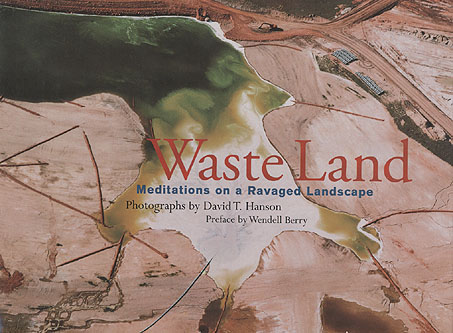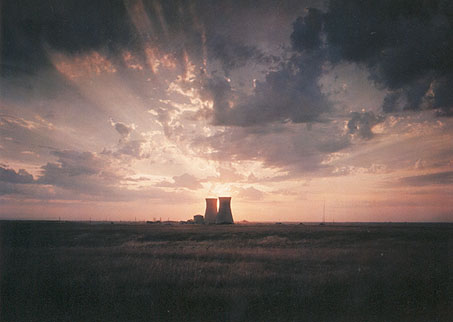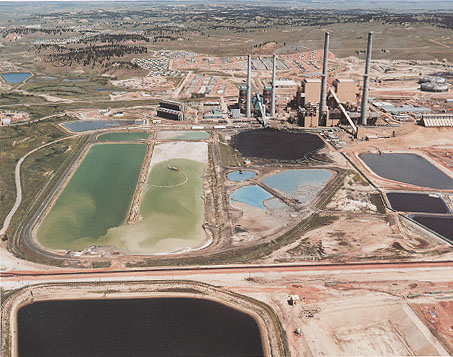Waste Land: Meditations on a Ravaged Landscape. New York: Aperture, 1997. Photographs by David T. Hanson, Preface by Wendell Berry. Afterword by Mark Dowie. Hardcover, 160 pages, $40.00. This piece originally appeared in The New Art Examiner (October 1998).

Can the seduction of beauty be used to arouse our social conscience? David T. Hanson's Waste Land: Meditations on a Ravaged Landscape (1997) argues it can. The photographer collects a large body of his formally astute, mainly aerial, color photographs of mined and maimed earth, hazardous waste sites, military installations, and power plants that bespeak of the pervasive presence of the machine in the garden.
Godfrey Reggio's Koyannisqatsi, a 1980s filmic attack on industrial blight, tried to achieve both beauty and social message, but many critics still said the aerial shots (high verticals and low obliques, also used by Hanson), his time-lapse photography, coupled with the absence of any narration, meant visual seduction triumphed the social message.
Privileging beauty over social critique, Sally Euclaire's touting of John Pfahl's series "Power Places" (1981-83) in New Color/New Work: Eighteen Photographic Essays (New York: Abbeville Press, 1984) noted Pfahl's art-for-art-sake intentions in his romanticized color photographs of nuclear- and coal-powered plants (see below). Espousing the New Criticism's penchant for ambiguity and a reactionary postmodernist nostalgia, she also observed that Pfahl's juxtapositionings of the machine in the garden were polysemous enough for them to be either praised by power company CEO's for their artful, luscious treatment of the subject or touted as chilling visions of an impending Götterdämmerung by ecologist and anti-nuclear groups.

Rancho Seco Nuclear Plant,
Sacramento, CA, June 1983 by John Pfahl
Contra Pfahl's romanticism, Hanson's images of industrial rape of our lands depicts the machine as having wholly ruined the garden. He knowingly anchors his images within maps and textual support that goes far to overcome the dilemma of producing either beauty or a social critique, and does so without their overcoming residing in mere ambiguity. Filled with text, maps, and photographic mappings, the book breaks down firm differences between the map and the territory, between sign and referent, a textual strategy Abigail Solomon-Godeau attributed to "New Documentary." Wendell Berry's Preface theorizes how Hanson's imagery should be read. He reasserts the traditional photographic dilemma of art/document, privileging the former term. He admits some may still view Hanson's images as merely "abstract art" or "beautiful shapes." But he attributes this to the fact that the lands were so ill-used by the abstract forces of technology that "nobody foresaw, because nobody cared, what they would look like."Berry then suggests two opposing correctives, each grappling with one horn of the art/document and beauty/instrumentality dilemma. One, the corrective of metaphor: that we see these beautiful images as "representations of bad art — if by art we mean the ways and products of human work"which are "symbolic of what we cannot see," the horrible seeping pollution. And two, the corrective of metonymy: that we attend to the images' referents, to "the things that are readily identifiable (trees, buildings, roads, vehicles, etc." so as to go beyond the abstraction and see "that their common subject is a monstrous ugliness."

Colstrip, Montana: Power
plant and waste ponds (1983 - 85) by David T. Hanson
The static either-beauty-or-social-critique dilemma is refashioned as a dialectical flux between present and absent appearances in Hanson's photographs: what easily appears (formally seductive abstraction, a sign rooted in land abuse)/ what doesn't appear (ugliness, only envisioned by mental effort when one attends to the signs' referents). Hanson's superb book reflects both a commitment to artful seeing and hard-hitting social comment.
--End--
James Hugunin teaches Photographic History and Critical Theory at The School of the Art Institute and is the Managing Editor of U-Turn E-zine.